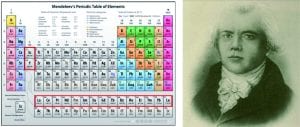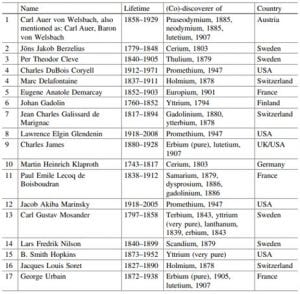Rare Earth Element : Elements of Power*

The location of the Rare Earth Element (REE) in the periodic table of elements (left) and Johann Gadolin, the man who discovered REE for the first time (right)
In the last few years, research on Rare Earth Element (REE) has become increasingly intensive, this is influenced by the fact that REE is used as a material for high-level technology such as batteries, smartphones, and even in the military. In 2009, China monopolized global REE production up to 97%, which caused worldwide concern and was known as the “Rare Earth Crisis”. Humphries (2010) defines Rare Earth Element and Yttrium (REY) as a group of metal elements that are included in the transition group or lanthanide chemical group on the periodic table. The Scandium (Sc) and Yttrium (Y) elements are also included in the REY group because of the similarity in physical and chemical properties of the lanthanide group. Rare Earth Element is also known by several other names, namely rare earth metals or rare earths.
Gadolin (1794) who was a chemist and mineralogist began the discovery of REE, the yttrium element for the first time at the end of the XVIII century. At the end of the XIX century, chemists and mineralogists were able to research and identify a total of 14 elements of REE. In 1907, the discovery of the element lutetium and promethium closed the history of the discovery of REE in the world, these two elements were the last elements to be discovered. The promethium element was discovered due to a nuclear reaction, which was discovered by Marinsky (1943).
Weeks (1968) stated that in general, the naming of REE elements usually refers to the discoverers of the elements themselves, for example the “Gadolinium” element discovered by Johan Gadolin and “Samarium” discovered by Samarskite, a Russian mining expert. Voncken (2015) mentioned that actually “Rare Earth Element” is a term used in the XIX Century, it is based on the discovery of the only one REE deposit in the world at that time, namely in the Ytterby region, Sweden, thus this deposit is considered something rare.
The Ytterby mine is a feldspar and quartz mine originated from pegmatite granite used for the porcelain needs of the United Kingdom and Poland. Mining activities at Ytterby began in late 1700 until 1933. Overall, almost all REE elements were discovered in this mine, such as yttrium, ytterbium, terbium, erbium, gadolinium, holmium, thulium, scandium, lutetium and tantalum. The history of the discovery and discoverer of the REE elements can be seen in the following table:
Table 1. The history of the discovery of REE elements

Rare Earth Element is classified as lithopile and is distributed in the earth’s crust and in the mantle. Referring to the name “Rare Earth Element”, these elements are actually widely distributed on earth and are relatively easy to be reached on the surface of the earth (Atwood, 2013). Looking at the historical development and potential of REE in the future, our task is to study and discover steps to explore REE extraction to meet the needs of these Elements of Power specifically in Indonesia, and the world in the future.
*Elements of Power : terminology by David S. Abraham, 2015.
SOURCES:
- Voncken, J. H. L. 2016, The Rare Earth Elements : An Introduction: Delft, Springer Briefs in Earth Sciences, 137 p.
- Atwood, D.A., 2013. The Rare Earth Elements: Fundamentals and Applications, John Wiley & Sons. 1171 p.
